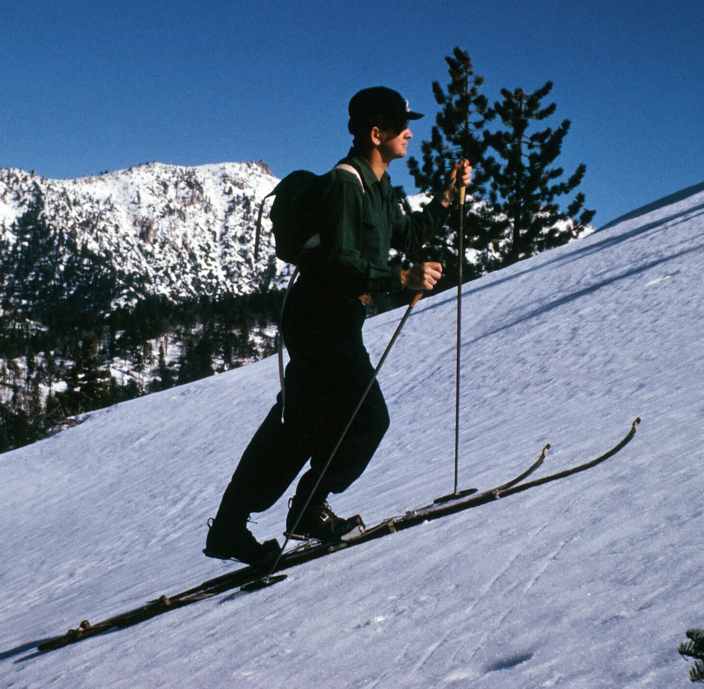One of my favourite hobbies is testing ski wax. I really like grip waxing, its infinitely adjustable. Add a few more thin layers for more grip. Cover a warmer wax with a harder wax to speed up a slow wax job. Its warming up move from wax A to wax B. Ah, klister.. It's just fun to play and experiment with grip waxes!
Yeah, I hear you. Not everyone has the time, patients and >20years of experience necessary to even start with a grip wax that "might work". And when you do get it right the snow conditions change you need to strip that wax job off and start again! Waxing, testing, rewaxing, slipping, gripping is a frustrating waste of time you would rather have for skiing. I get it. You just want to pick up your skis and go. Immediately!
Enter skin skis, the latest type of classic ski grip technology that claims it will replace the need for grip wax. If anyone is counting there's now classic skis you where you must apply grip wax, fishscales, a plethora of rub skis for 0C conditions, grip tapes, spray on waxes and now skin skis.
Skin skis aren't a modern idea. Nomadic hunters who traveled by ski realized that by putting seal furs underfoot they got better traction going uphills. Thus we call them skin skis, though they no longer use real animal pelts but rather a synthetic fur-like material made of mohair and nylon that is glued to the ski base where the grip wax would usually go.

Photo: Ascent with skins, John Surr en route to Slide Peak, CA. Photo credit: Jeffery Moore
Backcountry and alpine touring skiers have used removable skins to get up steep hills for decades. They attach to the skis at the tip and the tail with clips or loops and usually stay on the base with the help of adhesive. The skins allow the ski to glide forward but prevent any backslip. These skins are usually designed to be removed for skiing downhill however.

Modern cross country skin skis have taken the technology further. First the skis are engineered to have a high residual camber to keep the skin off the snow while gliding. This allows the skins to be permanently affixed to the grip pocket and still have good glide. Second the skins are often set in a recess in the ski base so as to sit flush with the base, again to improve glide. Finally skins are shaped and thickness is tapered to decrease the abrupt feeling as you weight the ski. (photo above)
There are a skin skis from all major cross country brands
Is it just a marketing gimmick to sell more skis? Apparently this is the second attempt to market skins skis. I've been told that several ski manufacturers marketed skin skis with little success in the 1980s. A few people rave about them to this day, medals were won on big races with them, but they never really became mainstream. I've heard some plausible theories as to why; poor manufacturing quality, the average skier knew how to wax and wasn't interested in multiple pairs of skis. I've also heard conspiracy theories that wax companies and the big ski brands were opposed to them and had them banned from racing so manufacturers backed off.
That's all well and nice but do they work?! To really answer that question I needed to test them. And so I have..
How do they grip?
The grip strength is excellent. I wasn't surprised by the grip given that I've skied on backcountry skins. It varies with conditions, but it well groomed hard tracks (crushed ice and man made snow) where you would be using blue or violet klister they are just as good as klister. Unlike fischscales that often fail in hard snow the skins were at there best in these conditions.
Grip was on par with wax on a day around -5C when it might be hard to decide if you needed klister or hard wax. Glide in this case was also excellent. As it warmed up to above zero there was no change in grip, though glide suffered a bit but was acceptable.
In softer snow conditions or untracked powder the grip is less secure than good wax but still reasonable. Glide here was also acceptable, but overall neither as good as a decent grip wax job.
I still have yet to sufficiently test them in that all important zero degrees and fresh snow condition. I think they will grip, but will they ice and what happens when there's a mix of wet, glazing and powder. Its too early for me to say.
How's the glide really?
If you've tried waxless skis before, you'll be pleasantly surprised by glide in all conditions. I found them faster than I assumed they would be in general. In very few instances is there noticeable drag. Glide much better than fishscales (crown skis) and don't make nearly as much noise. There can be a quiet hum, but not the loud "Zzzzzzttt" of fishscales that reminds you of all the glide you are giving away on each stride!
Drawbacks?
The caveat to skin skis being that you must buy skis with a camber that suits your weight. Grip and glide are going to be limited by ski selection. Too stiff and you'll be without any grip, and worse yet you can't just add more wax to get more grip - your stuck with the skin you've got! Too soft and that skin will drag noticeably. So you can't just own a pair and then put on a 25lbs backpack and expect them to work the same.
Also being very high camber skis, to keep the skins from dragging, you need to be able to weight shift well to make them work. Unlike fishscales were a minimal weight shift is usually enough to get grip, skins require true weight shift to get the skins in contact with the snow. For some recreational skiers this makes skin skis a bit less grippy and they might be tempted toward softer skis at the cost of glide.
Finally skins do need replacing, they do get dirty, they do require care and cleaning, they can ice up, they do require a bit of getting used to in terms of ski handling on downhills and corners.
So while not a magic ski that will work flawlessly in all conditions, they are superior to any other ski that doesn't require wax. And while I'll still pick wax everytime, they probably are the best solution for a lot of people.
Would you race on them?
People are using them with success in races. For loppets and longer tours it might seem tempting but it's a bit risky too. The skin is a piece of material glued to the ski. Ski over a rock and it can tear or peel off. Some skins have delaminated in cold weather, simply peeling off whole. You don't want to find yourself 1/3 of the way into a long day and end up with no grip and no easy fix. (Carry spare skins?)
In my next article I'll look at ways to prevent these problems.
Have experience with skin skis? Let me know what you think!


